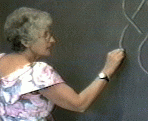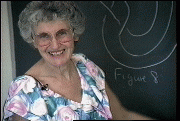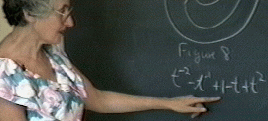|
|


Joan Birman |
|
|


Joan Birman |
|
Birman's yearning to understand how things work manifested itself at an early age: "My love of patterns--the swirling patterns of marbles as I spilled them out on the floor, and the matching of plaids as my mother was sewing skirts for me--merged right into formal math as I got older. I remember very clearly when an elementary school teacher asked about whether the sum and products of two odd numbers was even or odd, and how excited I was to understand it, and how beautiful it seemed that such patterns existed if you only knew enough to ask the right questions."At the all-girls' high school she attended, Birman developed her skill in asking the right questions as she and her fellow ``math lunatics" competed with one another to be the first to solve the geometry problems their teacher Miss Mahoney put on the board. While Birman enjoyed high school geometry, she was bored and confused in college calculus, which felt like a waste of time. Assuming that this course was typical of advanced mathematics, and therefore that she didn't have any talent for the subject, Birman was discouraged; it was only later, when her confidence was greater, that she realized the class was taught poorly. |



|
Birman's career path then followed a circuitous route: she took a professional detour after completing her bachelor's degree in mathematics to marry, work in the aircraft industry, and raise three children. Twenty one years later she returned to school to get her Ph.D., perhaps prompted by the work ethic that was instilled in her by her parents, first generation Americans who encouraged their four daughters to study hard because they believed that education was the secret to a better life. Her Ph.D. thesis advisor, Wilhelm Magnus, helped foster the confidence that was necessary for Birman to succeed by taking her seriously, even though she was ``the wrong age and sex to be a research mathematician." Magnus suggested an interesting and appropriate research problem, listened carefully to her ideas as they developed, and appreciated the originality of her solution when she found it. Today, Birman is Professor of Mathematics at Columbia University, where she does research in Knot Theory, an area of topology. |